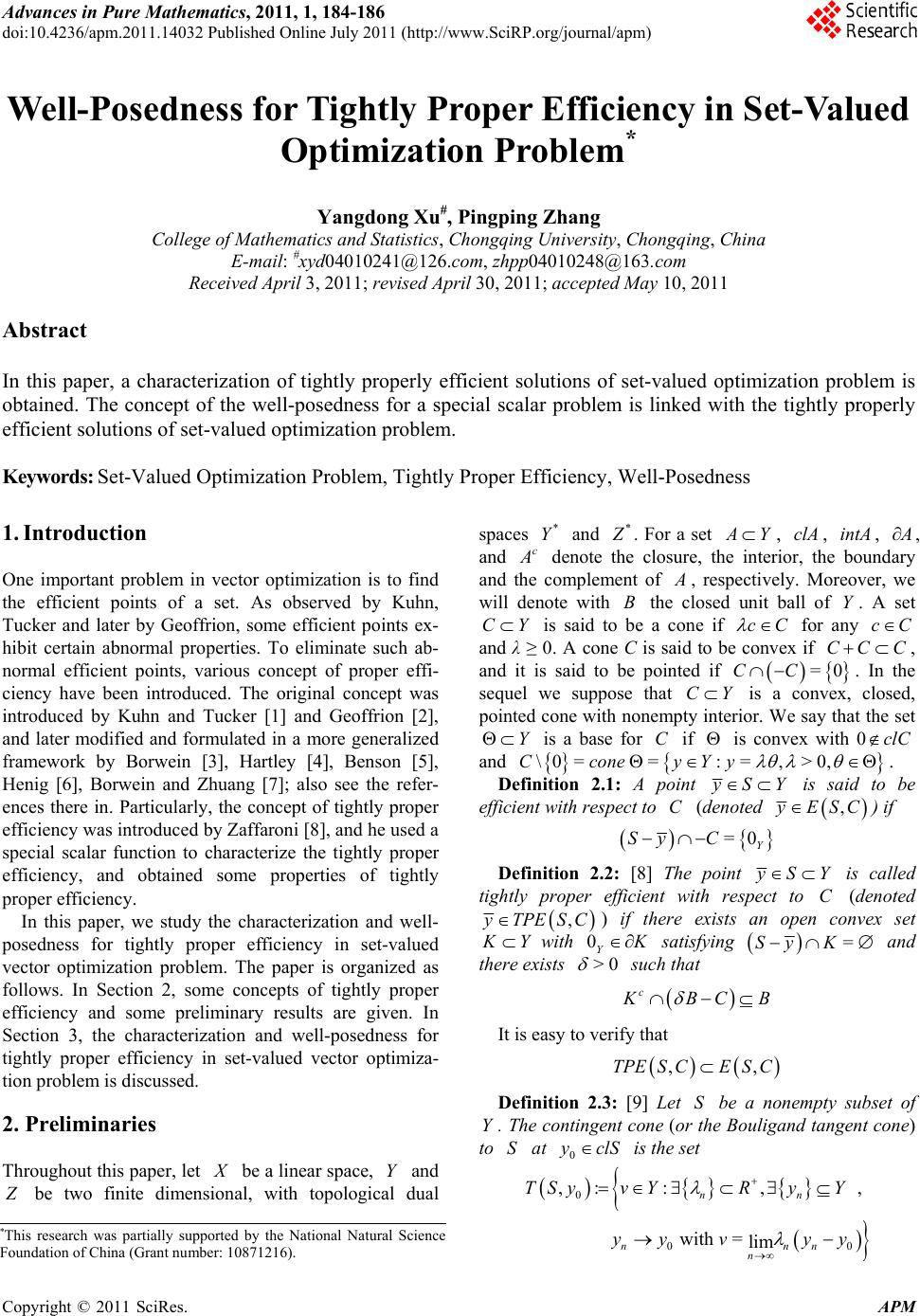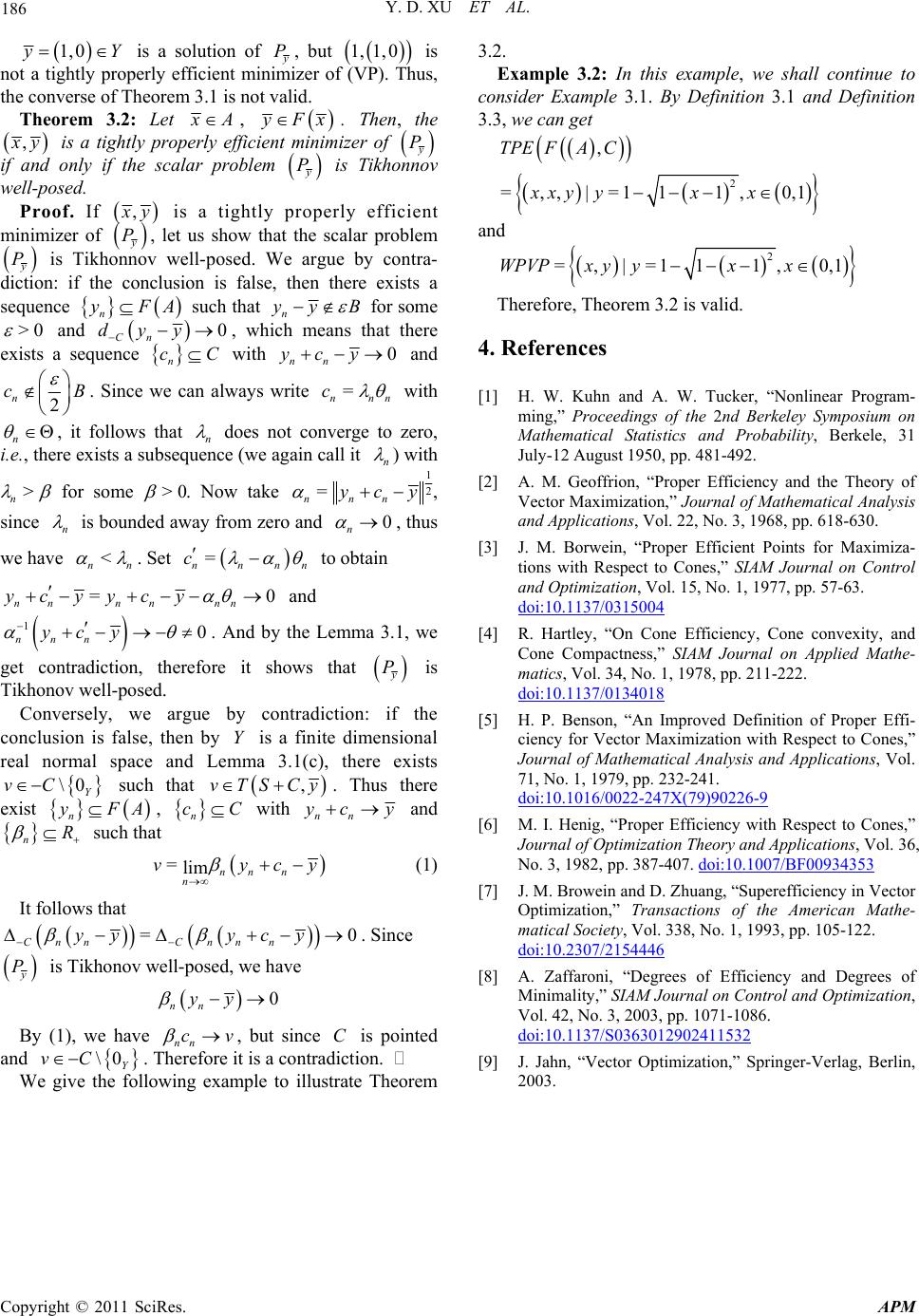Paper Menu >>
Journal Menu >>
 Advances in Pure Mathematics, 2011, 1, 184-186 doi:10.4236/apm.2011.14032 Published Online July 2011 (http://www.SciRP.org/journal/apm) Copyright © 2011 SciRes. APM Well-Posedness for Tightly Proper Efficiency in Set-Valued Optimization Problem* Yangdong Xu#, Pingping Zhang College of Mathematics and Statistics, Chongqing University, Chongqing, China E-mail: #xyd04010241@126.co m, zhpp0 4010248@163 .com Received April 3, 2011; revised April 30, 2011; accepted May 10, 2011 Abstract In this paper, a characterization of tightly properly efficient solutions of set-valued optimization problem is obtained. The concept of the well-posedness for a special scalar problem is linked with the tightly properly efficient solutions of set-valued optimization problem. Keywords: Set-Valued Optimization Problem, Tightly Proper Efficiency, Well-Posedness 1. Introduction One important problem in vector optimization is to find the efficient points of a set. As observed by Kuhn, Tucker and later by Geoffrion, some efficient points ex- hibit certain abnormal properties. To eliminate such ab- normal efficient points, various concept of proper effi- ciency have been introduced. The original concept was introduced by Kuhn and Tucker [1] and Geoffrion [2], and later modified and formulated in a more generalized framework by Borwein [3], Hartley [4], Benson [5], Henig [6], Borwein and Zhuang [7]; also see the refer- ences there in. Particularly, the concept of tightly proper efficiency was introduced by Zaffaroni [8], and he used a special scalar function to characterize the tightly proper efficiency, and obtained some properties of tightly proper efficiency. In this paper, we study the characterization and well- posedness for tightly proper efficiency in set-valued vector optimization problem. The paper is organized as follows. In Section 2, some concepts of tightly proper efficiency and some preliminary results are given. In Section 3, the characterization and well-posedness for tightly proper efficiency in set-valued vector optimiza- tion problem is discussed. 2. Preliminaries Throughout this paper, let X be a linear space, and Y Z be two finite dimensional, with topological dual spaces and * Y* Z . For a set A Y, , , clA intA A , and c A denote the closure, the interior, the boundary and the complement of A , respectively. Moreover, we will denote with the closed unit ball of Y. A set is said to be a cone if B CYcC for any cC and λ ≥ 0. A cone C is said to be convex if CC C , and it is said to be pointed if . In the sequel we suppose that is a convex, closed, pointed cone with nonempty interior. We say that the set CC =0 YC Y is a base for if is convex with 0CclC and , \0=Cc=e: =Yy , >0 ony . Definition 2.1: A point y SY is said to be efficient with respect to (denoted C , y ESC) if =0 Y C Sy Definition 2.2: [8] The point y SY is called tightly proper efficient with respect to C (denoted , y TPES C K ) if there exists an open convex set Y with 0Y K satisfying Sy=K and there exists >0 such that c K BC B It is easy to verify that ,,SS C 0 y TP clS E CE S Definition 2.3: [9] Let be a nonempty subset of . The contingent cone (or the Bouligand tangent cone) to at Y S is the set 00 with= lim nn n yy v yy 0 ,: ,y YR :,Y nn y n TS v *This research was partially supported by the National Natural Science Foundation of China (Grant number: 10871216).  Y. D. XU ET AL. 185 Jahn [9] have gotten the following proposition on the contingent cone to at S0 yclS . Proposition 2.1 a nonempty convex subset of a real normed space. Then : [9] Let S be ,=TS CclconeSy 3. Tightly Proper Efficiency and Well-Posedness onsider the following vector optimization problem with C set-valued maps: (VP) min F x, s.t. Gx D, x X, where :2 Y FX and :2 Z GX are set-valued maps, respectively. D is ax, pointed cone of closed,conve Z . Denuote the feasible soltion set of (VP) by thimage of := :9AxXGx D ande A under F by = xA F AFx Definition 3.1: A point x is said to proper efficient solution (VP) be a tightly of , if there exists y Fx such that ,yTPEFAC , and the point , x y of is said to be a tightly properly efficient minimizer e define (VP). Definition 3.2: For a set SY. Let the function R b \ = SSYS : SY d as y dy dy where =inf : S dy sys ith =dy S w . S was introduceThe function d inin properties are ged together in the following pro- position. osition 3.1: [8] Letbee wi , ather [8], its ma Prop a convex conth no C nempty interiorthen the function C is convex, positively homogenous and lipschitzian. Moreover, this function is negative on the interior of C null on C, and positive on int c C. We consider the parameterized scalar problem: y P min C y y s.t. y FA where y Y. Definition 3.3: Let y Y , the parameterized scalar optimization problem y P is Tikhonov well-posed if 1) =>0 CC yy dy for all y yFA with y y; 2) for all n y FA with 0 Cn dyy implies that n yy. denote by We =y WPVP Fyov we Lemma 3.1onsid llowing APis Tikhonllposed. : [8] Cer the fo statements: (a) the point y is a tightly properly efficient point in (b) there exists an open convex set such that S; KY \0 Y CK and =Sy K ; (c) ,=0 Y TS CC. If Y y n it holds that finite dim all stateents are equivalent. eorem ccterize the relation between parameterized scro is a any normed space, the ). If is ensional, we have () and ()) (abc also that()ca followi ( Y h m The harang t tightly properly efficient points of(VP) and the alar pblem y P. Theore et m 3.1: L x A , y Fx. The , x y is a tightly properly efficient minimizer of (VP), then y is a solution of y P. Proof. We show that y is a solution of the scalar problem y P. Indeed3.1 and Lemma 3.1(b), we have , by Proposition =0, CC y yd y yFA Noting y that =0 C dyy , thus we have that y is just the solution of y P. the problem otRemark 3.1: The converse of Theorem 3.1 mabe n valid, the following example can illustrate the case. 1: Let y Example 3.= X R, 2 =YR and = Z R. Given 2 =CR , =DR . [0,1] ,, F 2 ,111,xyR R yxifx =x x yRR otherwise =, 1,forany g xxx xX Thus, the feasible set of (VP) =| =[0,AxXGx R ) F A can see Figure 1. The set of F A. Figure 1. The set of Copyright © 2011 SciRes. APM  Y. D. XU ET AL. Copyright © 2011 SciRes. APM 186 , but 1, 1,0 (VP). Th 1,0 y Y is a solution of y P is not a tightly properly efficient minimizer ofus, the converse of Theorem 3.1 is not valid. Theorem 3.2: Let , y Fx x A. Then, the , x y is a tightly properly efficient minimizer of y P if and only if the scalar problem y P is Tikhonnov well-posed. Proof. If , x y is a tightly properly efficient minimizer of y P, let us show that the scalar problem y P is Tik well-posed. We argue by contr- diction: if the conclusion is false, then there exists a sequence honnov y a n FA such that n yyB for some >0 and 0 n yy, which means that there exists a sequence n cC with C d 0 nn ycy and 2B . Since we ay=nnn c can alws writen c with n , it follows that n does not coverge to zero, i.e., there exists a subsequence (we agall it n n ain c ) with > n for som> e 0 . Now take 1 2 = nnn ycy , since n is bounded away from zero and 0 n , thus we have < nn . Set = nnnn c to obtain =0 nn n ycy nnn ycy and 1 nnn ycy And by1, we 0 . the Lemma 3. get contrathat diction, therefore it shows y P is posed. Tikhonov well- Con en real norme and L), there exist th versely, we argue by contradiction: if the conclusion is false, then by Y is a finite dimsional al spacemma 3.1(cs \0 suchat Y vC vTSC e ,y. Thus ther exist n y FA, n cC with n y and n c y nR that such =lim nn ny n vyc (1) It follows that =0 CnnCnn n yy ycy . Since y P is Tikhonov well-posed, we have 0 nn yy By (1), we have nn cv , but since C is pointed and 0 Y. Therefore it is a contradiction. \vC Wewi ple to ile Theorem lu 3.2. example strat Example 3.2: In this , we shall continue to consider Example 3.1. By Definition 3.1 and Definition 3.3, we can get give the follong exam 2 =, ,|=111, 0,1xxy yxx and ,TPE FAC 2 =,|=111,0,1WPVPx yyxx Therefore, Theorem 3.2 is valid. ferences [1] Program- sium on tatistics and Probability, Berkele, 31 t 1950, pp. 481-492. ] A. M. Geoffrion, “Proper Efficiency and the Theory of Journal on Control 4. Re H. W. Kuhn and A. W. Tucker, “Nonlinear ming,” Proceedings of the 2nd Berkeley Sympo Mathematical S July-12 Augus [2 Vector Maximization,” Journal of Mathematical Analysis and Applications, Vol. 22, No. 3, 1968, pp. 618-630. [3] J. M. Borwein, “Proper Efficient Points for Maximiza- tions with Respect to Cones,” SIAM and Optimization, Vol. 15, No. 1, 1977, pp. 57-63. doi:10.1137/0315004 [4] R. Hartley, “On Cone Efficiency, Cone convexity, and Cone Compactness,” SIAM Journal on Applied Mathe- matics, Vol. 34, No. 1, 1978, pp. 211-222. doi:10.1137/0134018 [5] H. P. Benson, “An Improved Definition of Proper Effi- (79)90226-9 ciency for Vector Maximization with Respect to Cones,” Journal of Mathematical Analysis and Applications, Vol. 71, No. 1, 1979, pp. 232-241. doi:10.1016/0022-247X [6] M. I. Henig, “Proper Efficiency with Respect to Cones,” Journal of Optimization Theory and Applications, Vol. 36, No. 3, 1982, pp. 387-407. doi:10.1007/BF00934353 [7] J. M. Browein and D. Zhuang, “Superefficien Optimization,” Transactions of the cy in Vector American Mathe- matical Society, Vol. 338, No. 1, 1993, pp. 105-122. doi:10.2307/2154446 [8] A. Zaffaroni, “Degrees of Efficiency and Degrees of Minimality,” SIAM Journal on Control and Optimization, Vol. 42, No. 3, 2003, pp. 1071-1086. doi:10.1137/S0363012902411532 [9] J. Jahn, “Vector Optimization,” Springer-Verlag, Berlin, 2003. |

